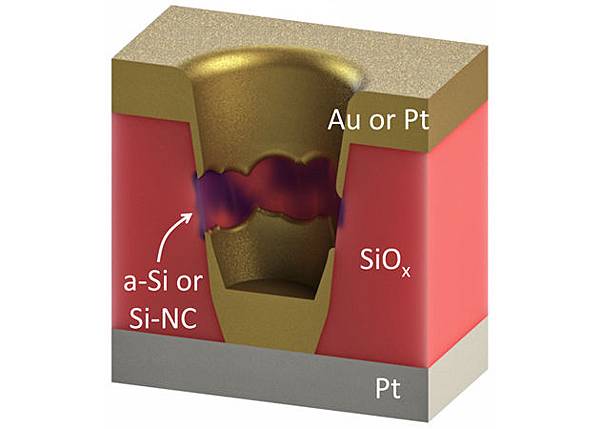
除了超高解析的螢幕以外,現在大家對於旗艦機的記憶體(RAM)要求,應該都是非 3GB 就看不上眼吧?不過在萊斯大學最新的電阻式記憶體(RRAM)研究的面前,這樣的容量大概就會被當成尾數去掉了呢(驚)。RRAM 所使用技術並非傳統 Flash 採用電晶體為單元而是以電阻所組成,卻也同樣具備無需持續供電的優勢。
而且 RRAM 技術可以更輕鬆層疊以更有效地增加單晶片的儲存空間。重點是,新的技術可在室溫環境與較低能耗之下生產,大幅度地改善了以往需要超高溫、高電壓的低良率高成本製程,降低了製作難度。而綜合以上的優勢所得到的結果就是,為了將可在一張郵票大小的晶片中,獲得 TB 級的超大記憶體容量。很難想像吧?跳轉以後觀看更詳細的介紹。
這次的技術突破點在於,研究團隊改採以金屬(金或銀)填入僅有 5 nm 寬的奈米級二氧化矽層的孔縫之中的方式,並且以兩片非常薄的金屬包覆來製成電極。這樣製作方式相較以往將可大幅降低成本,並且可以增加一百倍的使用次數,儲存單元的密度也因此大幅增加 -- RRAM 的每個 Cell 單元可儲存 9 bits(Flash 則是僅有 3 bits)-- 這樣的成果讓我們普遍見到的 RAM 記憶體的容量單位,一躍到了在固態硬碟 SSD 上才會見到的 TB 級容量大小,但所需要的體積卻是迷你很多。
這樣說好了,一間已經準備推出相關產品的公司 Crossbar 表示,使用這樣技術的記憶體晶片可以使 1TB 的記憶體,容納在僅僅一張郵票大小的晶片尺寸中,而這樣的特性不正是極度適合行動裝置嗎?雖說該公司目前的計劃是要把這樣的科技,應用在一些 embedded 用途與汽車上,所以短期之內應該暫時不會看到搭載此技術的消費型商品。但研究團隊也表示未來幾週也會與其他廠商接觸,所以也不能說這樣的未來還距離我們很遠囉(期待)。

Illustration: Tour Group/Rice University
RRAM stores bits as resistance rather than charge. Conductive filaments form across the silicon oxide when voltage is applied.
Resistive random-access memory (RRAM) has promised a new generation of computer memory by decreasing the size of memory cells through the storage of data as resistance rather than charge. With RRAM, a dielectric material is sandwiched between two electrodes so that when a voltage is applied ions are pulled from one of the electrodes, forming conductive filaments that lower the cell’s resistance.
Research has focused on finding the best material for the dielectric, and a wide variety of materials are being pursued, including paper.
Since 2010, James Tour and his colleagues at Rice University have beenpursuing silicon dioxide as the dielectric material for a RRAM cell after they discovered conductive filament pathways can be formed in the material. Now Tour and his colleagues have taken another step in making silicon oxide the basis for high-density, next-generation computer memory.
The Rice team has refined the production of the memory cells to make it possible to fabricate the devices at room temperature with conventional production methods.
Companies are looking to win at RRAM using a variety of materials, such as Panasonic’s use of tantalum oxide and others the development of hafnium oxide. But Tour and his colleagues recently published a paper in the journal Nano Letters that makes the case that nanoporous silicon oxide is superior to the other technologies.
“Our technology is the only one that satisfies every market requirement, both from a production and a performance standpoint, for nonvolatile memory,” Tour said in a press release. “It can be manufactured at room temperature, has an extremely low forming voltage, high on-off ratio, low power consumption, nine-bit capacity per cell, exceptional switching speeds and excellent cycling endurance.”
Tour comes to this conclusion after the latest version of silicon oxide produced by the Rice researchers exceeded previous versions in a number of important performance parameters. The Rice team used a nanoporous version of silicon dioxide that reduced the amount of voltage needed to create the conductive pathways down to less than two volts. This represents a 13-fold improvement over the team’s previous best. And it brings silicon oxide right back into the running against competing materials.
The researchers were also able to eliminate the need to fabricate so-called device edge structures. “That means we can take a sheet of porous silicon oxide and just drop down electrodes without having to fabricate edges,” Tour said. “When we made our initial announcement about silicon oxide in 2010, one of the first questions I got from industry was whether we could do this without fabricating edges. At the time we could not, but the change to porous silicon oxide finally allows us to do that.”
The advantages of switching to a nanoporous variety of silicon oxide didn’t end there. The new porous version allows the cell to endure 100 times as many write-erase cycles as the previous version. Additionally, the porous silicon oxide cell's capacity to hold up to nine bits is the highest number among oxide-based memories, the Rice team claims.
The research team reports that they have already received overtures from companies interested in licensing the technology.
Source:IEEE
Source:http://chinese.engadget.com/2014/07/25/future-phone-terabyte-storage/?ncid=rss_truncated



 留言列表
留言列表